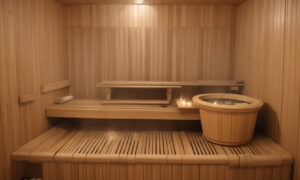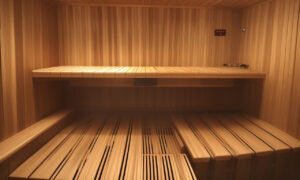Stepping into the soothing embrace of a sauna is more than just an indulgence; it’s a journey of thermal transformation. As the warmth permeates through the wooden cocoon, your body responds with a symphony of physiological reactions—central to which is the profound effect on your hydration levels. Unraveling the mysteries of how much water you lose in a sauna can be as intriguing as the sauna experience itself. The surprising truth lies within the heart of this timeless tradition, a health ritual celebrated across cultures for its revivifying benefits.
It’s not just about the beads of sweat glistening on your skin; it’s about understanding the intricate balance of water in your body. While most people cherish the sauna for its relaxation and detoxification perks, few pause to consider the actual impact it has on their fluid balance. Let’s dive deep into the steamy facts and uncover the essence of water loss during a sauna session, an insight that might reshape how you think about this ancient practice.
The Science of Sweat and Sauna
Understanding the Sauna Effect
Saunas have this almost mystical ability to make us sweat profusely, an effect achieved through elevated temperatures ranging between 150°F and 195°F (65°C-90°C). At the core of the sauna’s charm is heat exposure, which significantly raises the body’s core temperature, inducing a state of hyperthermia.
Related article; infrared sauna electricity cost
The Physiology of Sweating
Sweating is your body’s innate cooling mechanism, a critical response to regulate temperature. Sweat glands spring into action as the mercury rises, releasing moisture onto the skin’s surface. When this moisture evaporates, it carries away heat, thus cooling the body. But the evaporation of sweat is not just about temperature regulation; it’s also a route for expelling toxins and a significant source of water loss.
Quantifying Water Loss in the Sauna
Factors Influencing Sweat Rate
The truth about water loss in the sauna is influenced by several factors, including the duration of the sauna session, the sauna’s temperature, individual physiology, and even acclimation to heat. Each person’s sweat rate is unique, and this rate dictates the volume of water loss experienced during a sauna visit.
Related article; should you shower after sauna
The Role of Heat Acclimatization
Regular sauna-goers may find that their bodies have adapted to the heat over time, becoming more efficient at sweating and regulating core temperature. This heat acclimatization means that seasoned sauna users might experience a different level and rate of hydration shift compared to novices.
Related article; how long should i sit in sauna after workout
The Surprising Truth About Sauna-Induced Hydration Shifts
Engaging in a sauna session can lead to a significant loss of water, and the statistics can be eye-opening. Studies suggest that the average person might lose anywhere between a pint to over two pints of water—equivalent to approximately half a liter to a full liter—during a typical sauna session. But there’s more to the hydration shift than just numbers.
Related article; optimal sauna temp
The Impact on Electrolytes
It’s not just water that we’re sweating out. Electrolytes—crucial minerals like sodium, potassium, and magnesium—are also lost in the mix. This electrolytic shift underscores the importance of not only replenishing fluids but also ensuring that the body’s electrolytes remain balanced post-sauna.
Related article; shower sauna conversion kit
Individual Variability in Water Loss
Each sauna enthusiast has a unique response to the heat. Body composition, metabolic rate, and even one’s hydration status before entering the sauna can influence the total water loss during a session. Therefore, the figures mentioned above can vary widely from person to person, making personalized hydration strategies vital.
Related article; when is the best time to sauna
Replenishing Your Fluids: The Art of Post-Sauna Hydration
The Need for a Hydration Plan
Post-sauna rehydration isn’t simply about guzzling water. There’s an art to it, necessitating a thoughtful approach to replenish what’s been lost. An effective hydration strategy will take into account both fluids and electrolytes, ensuring that the body achieves a harmonious state of rehydration.
Related article; sauna before or after cryotherapy
Strategies for Efficient Rehydration
- Hydrate Beforehand: Begin well-hydrated to mitigate the intensity of fluid loss.
- Listen to Your Body: Use thirst as a guide but don’t rely solely on it, as it may not be an immediate indicator of dehydration.
- Quality Over Quantity: Choose beverages that contribute to both fluid and electrolyte restoration, such as water enriched with mineral salts, or even a sports drink, if appropriate.
- Pacing is Key: Slow and steady rehydration is preferable to drinking a large volume of water at once, which can overwhelm the body’s ability to absorb and effectively utilize it.
Uncovering the Health Benefits Beyond Hydration
Detoxification Through Sweating
Saunas are often lauded for their detoxification effects. Eliminating toxins through increased sweat production is a process that feels as good as it sounds. By stimulating the body’s innate purging processes, saunas can aid in the removal of toxins such as heavy metals and aid in overall wellness through detoxification.
Related article; infrared sauna after surgery
Relaxation and Stress Reduction
The sense of tranquility that envelopes you in a sauna session is palpable. The heat helps to relax muscles, ease tension, and promote a sense of calm. This psychological and physical relaxation can have profound implications for stress reduction and mental health.
Cardiovascular Health Implications
Studies have hinted at the positive effects of saunas on cardiovascular health. Regular sauna use has been associated with improvement in circulation, decreased blood pressure, and even a lower risk of heart-related events in the long term.
Immune System Boost
Regular exposure to the heat of a sauna might give your immune system a slight nudge. By potentially increasing white blood cell count, saunas could help in strengthening your body’s defense mechanisms against infections and illnesses.
Practical Tips for Maximizing Your Sauna Experience
Preparing for a Sauna Session
- Stay Hydrated: Ensure you’re adequately hydrated before even stepping foot into a sauna.
- Time Your Sessions Wisely: Limit sauna sessions to the recommended duration of 15-20 minutes, especially for beginners.
- Consider Sauna Etiquette: Understand and respect sauna culture and customs, including considerations of quietude, respect for shared spaces, and cleanliness.
During Your Sauna Session
- Listen to Your Body: Be attentive to how you feel. If you become uncomfortable or dizzy, it’s best to leave the sauna immediately.
- Maintaining Mindfulness: Use the time in the sauna for reflection or meditation, amplifying the mental health benefits.
Post-Sauna Recovery
- Cool Down Gradually: After leaving the sauna, allow your body to cool naturally. A cool shower can accelerate this process, but avoid shocking your system with extremely cold water.
- Rehydrate Thoughtfully: Begin your hydration process as detailed earlier, focusing on a balance of water and electrolytes.
Common Myths and Misconceptions About Sauna Water Loss
Myth: More Sweat Equals a Better Detox
While sweating does help remove some toxins from the body, it’s not the only factor that constitutes an effective detox. The liver and kidneys are the primary detoxification organs, and sweating complements their function rather than replacing it.
Myth: You Can "Sweat Out" a Cold in a Sauna
While sauna use can temporarily relieve some symptoms of a cold, such as congestion, it’s not a cure. It’s essential to note that if you’re sick, especially with a fever, using a sauna may not be advisable.
Myth: Saunas Burn Significant Calories
Although a sauna session can increase your heart rate similar to moderate exercise, the calories burned are relatively minimal. It’s vital to maintain realistic expectations about weight loss directly related to water loss in the sauna, which is temporary.
Moving Forward: Embracing the Full Sauna Experience
As you step out of the sauna, feeling refreshed and rejuvenated, understanding the intricacies of water loss and rehydration becomes part of your wellness lexicon. You’re now equipped to embrace the full sauna experience with a conscious appreciation for the delicate balance of hydration your body navigates through each session.
It’s not just the heat, the sweat, or the quiet contemplation that defines the sauna experience; it’s the holistic engagement of body, mind, and spirit, anchored by the understanding of how much water you lose in a sauna. The path to optimal sauna enjoyment is paved with knowledge, mindfulness, and a renewed respect for the body’s remarkable adaptive power.
In conclusion, saunas are more than just rooms of heat; they’re sanctuaries of health, where every drop of sweat tells a story of purification, relaxation, and self-care. The water you lose is a testament to the sauna’s potent influence on your body’s systems—a narrative of loss that transforms into a story of gain when viewed through the lens of holistic well-being.




